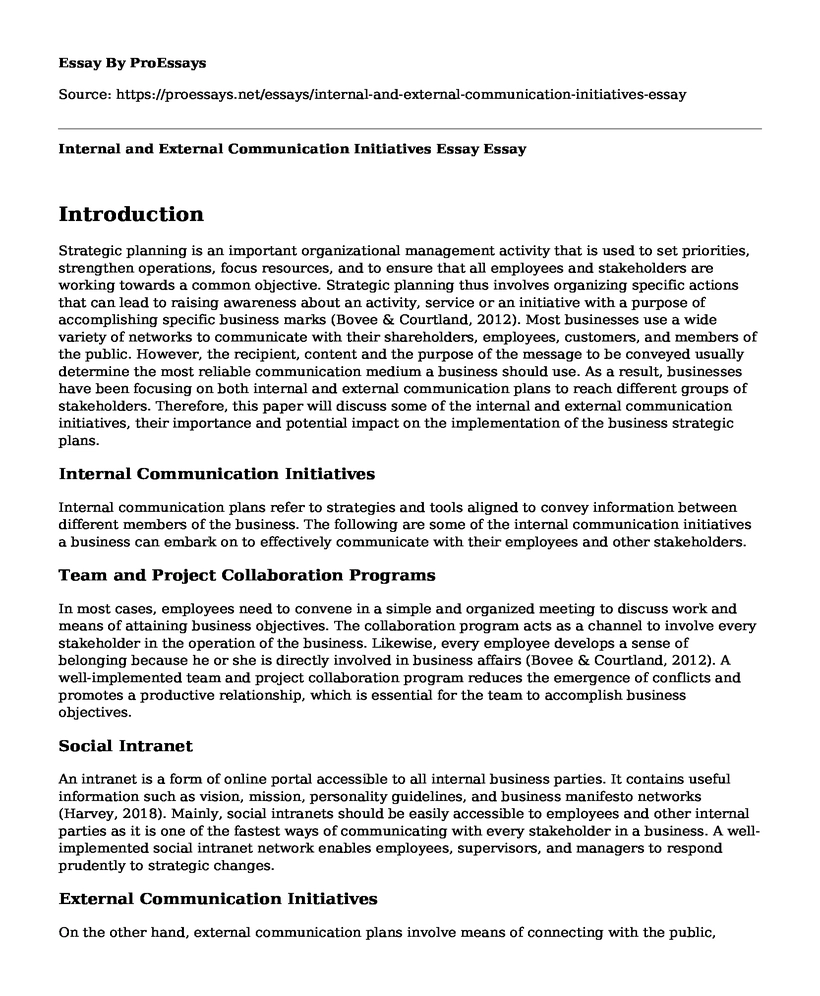Introduction
Strategic planning is an important organizational management activity that is used to set priorities, strengthen operations, focus resources, and to ensure that all employees and stakeholders are working towards a common objective. Strategic planning thus involves organizing specific actions that can lead to raising awareness about an activity, service or an initiative with a purpose of accomplishing specific business marks (Bovee & Courtland, 2012). Most businesses use a wide variety of networks to communicate with their shareholders, employees, customers, and members of the public. However, the recipient, content and the purpose of the message to be conveyed usually determine the most reliable communication medium a business should use. As a result, businesses have been focusing on both internal and external communication plans to reach different groups of stakeholders. Therefore, this paper will discuss some of the internal and external communication initiatives, their importance and potential impact on the implementation of the business strategic plans.
Internal Communication Initiatives
Internal communication plans refer to strategies and tools aligned to convey information between different members of the business. The following are some of the internal communication initiatives a business can embark on to effectively communicate with their employees and other stakeholders.
Team and Project Collaboration Programs
In most cases, employees need to convene in a simple and organized meeting to discuss work and means of attaining business objectives. The collaboration program acts as a channel to involve every stakeholder in the operation of the business. Likewise, every employee develops a sense of belonging because he or she is directly involved in business affairs (Bovee & Courtland, 2012). A well-implemented team and project collaboration program reduces the emergence of conflicts and promotes a productive relationship, which is essential for the team to accomplish business objectives.
Social Intranet
An intranet is a form of online portal accessible to all internal business parties. It contains useful information such as vision, mission, personality guidelines, and business manifesto networks (Harvey, 2018). Mainly, social intranets should be easily accessible to employees and other internal parties as it is one of the fastest ways of communicating with every stakeholder in a business. A well-implemented social intranet network enables employees, supervisors, and managers to respond prudently to strategic changes.
External Communication Initiatives
On the other hand, external communication plans involve means of connecting with the public, suppliers, and customers. Mainly external communication plans share the business market mix with the world (Bovee & Courtland, 2012). The following are some of the external business communication initiatives
Live Events and Conferences
Live events such as seminars and exhibitions are some of the means businesses use to connect with potential shareholders, partners, suppliers, and customers. Despite having other forms of reaching external parties ace to face interaction helps businesses to create a lucrative relationship with their target audience networks (Harvey, 2018). As a result, a business can attract, pursued and convince potential customers, which in return increases their sales volume. Therefore, the effective use of live events and conferences will promote business sales and profitability.
Emails and Newsletters
For the majority of modern businesses, emails and newsletters are some of the most effective forms of marketing strategies. Mainly, the use of emails and newsletters not only introduce new products to existing customers but it also builds a powerful relationship between the business and external networks (Harvey, 2018). Likewise, a business can group their emails and newsletters based on their market segments. Effective implementation and integration of emails to other external communication strategies, therefore, ensure that businesses send their intended message to a specific target market. The use of emails and digital communication networks is economical and reliable. As a result, businesses consider them in their marketing strategies.
Conclusion
In conclusion, an effective communication plan ensures that business networks run smoothly and every stakeholder remains focused on the overall business objectives. It also helps to focus and code a given message in relation to the prevailing situation and target audience. Likewise, communication initiatives directly influence productivity and day-to-day operations of a business. Businesses should, therefore, align their internal and external communication initiatives towards a common strategic objective and plans.
References
Harvey, S. (2018). External Communication Strategies: Finding Your Marketing Megaphone.Retrieved from http://fabrikbrands.com/external-communication-strategies.
Bovee & Courtland. (2012). Business Communication Today, 10/e. Pearson Education India.
Cite this page
Internal and External Communication Initiatives Essay. (2022, Sep 22). Retrieved from https://proessays.net/essays/internal-and-external-communication-initiatives-essay
If you are the original author of this essay and no longer wish to have it published on the ProEssays website, please click below to request its removal:
- Organization Theory, Behavior, Organic Organization, Mechanic Organization Mission and Vision Statement
- Social Support: Understanding Instrumental, Appraisal, Emotional, and Informational Support
- Essay Sample on Race: Social Construct or Observed Reality?
- Essay Example on Purple Cloud: Economic Woes and Viable Solutions
- Essay Example on Healing Racial Trauma: Kenneth V.H. on Hidden Wounds
- Essay Example on One Tweet, One Life: Jon Ronson and Justine Sacco's Story
- Free Paper: Methods and Theories of Art History







